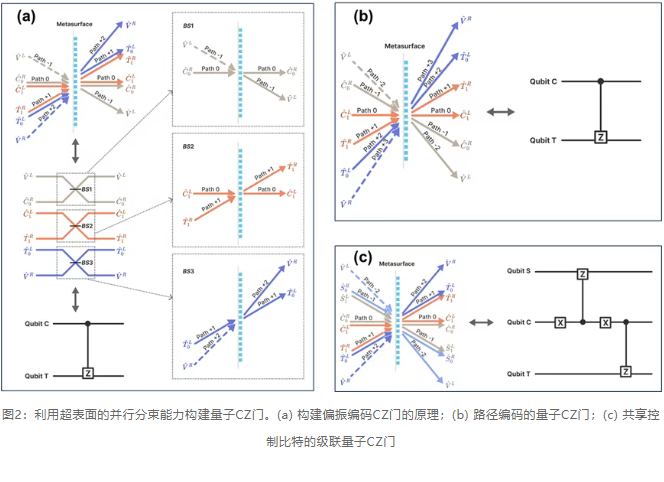16
2025
-
07
Quantum logic gates based on single-piece gradient metasurface
Author:
In today's rapidly developing quantum information technology, realizing efficient and highly integrated quantum logic gates is one of the key challenges in the field of integrated quantum optics. Recently, the research teams of Gu Ying and Gong Qihui from Peking University, in collaboration with Professor Li Guixin from Southern University of Science and Technology and Professor Ren Xifeng from University of Science and Technology of China, have made new progress in the integration of photonic quantum logic devices. The research team proposed a theoretical scheme for realizing a quantum controlled-phase gate based on a single-chip gradient metasurface, providing a new technological path for ultra-compact on-chip quantum information processing. The relevant results are published in Quantum CZ gates on a single gradient metasurface ”为题发表于 'Light: Science & Applications' Liu Qi, a doctoral student at Peking University, is the first author of the paper, and Professor Gu Ying from Peking University is the corresponding author.
Integrated photonic quantum computing and on-chip photonic quantum information processing are rapidly developing frontier fields, promising to revolutionize traditional computing and communication technologies. The realization of two-bit entangled quantum gates, such as the controlled-NOT (CNOT) and controlled-phase (CZ) gates, is fundamental to accomplishing general quantum information processing tasks. However, integrating quantum logic gates into scalable and efficient chip systems remains a significant challenge. Conventional quantum logic gate schemes typically rely on bulky optical beam splitters or waveguides, which have many limitations in terms of device size, scalability, and efficiency. Simultaneously, high-fidelity quantum logic gate operations are difficult to achieve due to manufacturing asymmetries, crosstalk, and unnecessary losses.
The rise of metasurface technology has provided new ideas for solving this problem. A metasurface is a novel planar optical platform that can precisely manipulate the phase, amplitude, and polarization of light at the subwavelength scale. In addition, the compact structure of the metasurface allows it to be compatible with existing chip manufacturing processes, making it possible to realize high-density integrated quantum photonic chips. These characteristics make metasurfaces exhibit enormous application potential in the field of quantum optics, especially in the preparation, manipulation, and measurement of quantum states. Although exciting progress has been made, how to use metasurfaces to realize basic quantum logic gates, such as quantum CZ gates, remains an urgent problem to be solved.
In the research team's previous research, it was found that a single-chip geometric phase gradient metasurface can function similarly to a parallel array of beam splitters, i.e., parallel beam splitting. In this work, the multi-photon interference capability provided by metasurface parallel beam splitting was further utilized. By reasonably designing the beam splitting ratio and selecting three adjacent circularly polarized beam splitting processes, a polarization-encoded CZ gate was successfully constructed on a single metasurface [as shown in Figure 2(a) ].

Because the parallel beam splitting processes of the metasurface are relatively independent and have the ability to work in parallel, using the remaining path-polarization modes supported by the metasurface for photonic qubit encoding, a path-encoded CZ gate can be implemented on the same metasurface [as shown in Figure 2(b) ], as well as multiple independently operating polarization or path-encoded CZ gates. In addition, the characteristic that adjacent beam splitting processes on the metasurface share the same path can be used to cascade two CZ gates, directly constructing a simple three-bit operational quantum circuit on the metasurface[ Figure 2(c) ]。
The metasurface quantum CZ gate not only performs quantum logic functions but also has a certain quantum error filtering capability. In the path encoding case, because the metasurface provides path-polarization correlation characteristics, each qubit is encoded by two correlated degrees of freedom. By detecting the path-polarization correlation characteristics of single photons, some bit-flip errors can be filtered out.
Applications and Prospects
This research provides new ideas for the integration of ultra-compact on-chip quantum logic devices. Multiple quantum CZ gates can be parallelized and simple quantum circuits can be directly constructed using a single metasurface, providing theoretical guidance for multi-functional integration on a single device. Further combining quantum logic operations with the multi-freedom correlation control capabilities of metasurfaces is expected to realize the preparation of high-dimensional entangled states, quantum error detection, and quantum error correction based on metasurfaces, opening up new avenues for quantum information integration based on metasurfaces.
LATEST NEWS
2025-08-20
High-order vortex beams assist super-resolution imaging
Recently, Professor Huang Zhiwei from the Department of Biomedical Engineering at the National University of Singapore led a biophotonics team in a latest study proposing that by introducing higher-order vortex beams into the minimal light flux (MINFLUX) imaging technology, the measurement accuracy of the imaging system can be significantly improved, thereby further breaking through the resolution limits of traditional optical imaging.
2025-08-20
Intrinsic Higher-Order Topological Insulators Based on Equivalent Medium Systems
Recently, Dr. Shaojie Ma, a young researcher at the Fudan University Institute of Future Information Innovation, Professor Lei Zhou from the Department of Physics, and Professor Shuang Zhang from the Department of Physics at the University of Hong Kong collaborated to achieve breakthrough progress in the field of topological state research, proving for the first time at both theoretical and experimental levels that intrinsic higher-order topological insulators (HOTI) exist in uniform electromagnetic media.
2025-08-20
Research on Non-Hermitian Properties Assisted by Orbital Angular Momentum Synthesis Dimensions
In quantum mechanics, observables usually need to satisfy Hermiticity to ensure that their eigenvalues are real numbers.
2025-08-20
Differentiable imaging unlocks full-link optimization
In the field of computational imaging, uncertainty has long constrained technological development.
2025-08-20
Reconfigurable multifunctional integrated optical computing chip
The development of artificial intelligence is driving the evolution of computing architecture towards higher performance, lower power consumption, and greater adaptability.

